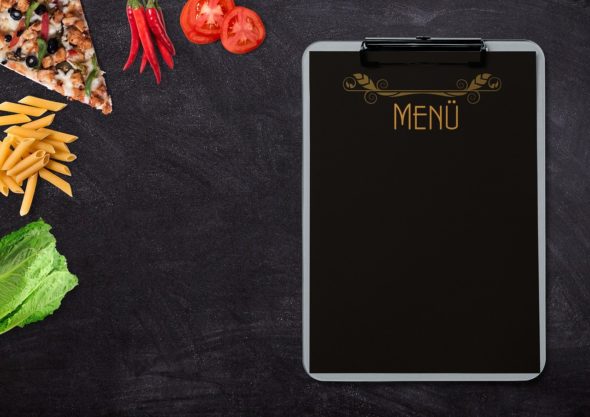Designing the Menu for Your New Restaurant


Ever heard the saying, “the first bite is with the eyes?”
When customers first see their dish placed in front of them, it creates a powerful first impression that affects what they taste. But the real first impression happens minutes earlier, back when they get their hands on your menu.
Creating the right menu can solidify your branding and personality, influence customers to buy certain foods, and add to the overall vibe of your restaurant. So how do you make the most of yours?
Designing menu options doesn’t have to be hard. Restaurants can take notes from current establishments that have been in the industry of food preperation and delivery for years. Here are a few tips to get you started.
1. Make a List of What You’ll Offer
Before you start with your menu design, it’s a good idea to make a reference list with all available menu options. From there, you can group each dish logically, starting the menu with appetizers and entrees before continuing to desserts.
Looking at the list, decide if there are any items you’d like to highlight. These should include any items that offer you the highest profit margins.
2. Consider Eye-Scanning Patterns
Many restaurants have designed menus around the assumed “sweet spot” in the upper right-hand corner of the menu. Conventional wisdom told us that our eyes are naturally drawn to that location. However, new work has found that we prefer to read menus like a book, from left to right.
3. Opt for Graphics and Illustrations Over Photos
A menu heavy on photos brings associations of chain restaurants. If you want to stand out from the crowd and showcase your brand, consider a clean menu template with polished graphics or illustrations.
4. Drop the Dollar Signs
Some classic research has found that guests given menus with numerical prices-that is, numbers with no dollar signs attached-spent “significantly more” than those whose menus included currency tags. Consider dropping the dollar signs for a little more revenue.
5. Draw Attention to Key Items
Boxes and borders can be a great way to divide the sections of your menu, but they can also help you promote specific dishes or types of food. You can also use illustrations and font changes to set certain items apart from the crowd.
6. Consider Your Color Scheme
There are several approaches you can take when considering the colors of your menu templates.
First, you can use the existing palette featured in your restaurant branding. This is a great idea if you’re trying to standardize your decor and create a consistent feel to your offerings.
You can also choose minimal, fuss-free color schemes that include fewer colors. There’s a reason high-end restaurants often have simple black and white menus: it exudes class.
However, you may also want to consider the psychological effects of colors in relation to food. Certain palettes will suppress or enhance our appetite, so taking advantage of the right hues may give you more bang for your buck.
7. Find a Good POS System
Once you have your menu decided, you’ll want to make sure that the point of sale system you have in place can accommodate it. Making it easy for your employees to use as well as make any changes to dishes at the customer’s request. Take a look at https://revelsystems.com/cloud-based-ipad-pos/ for an example system.
Designing Menus That Work
Your menu isn’t just a list of your dishes. Treating it like a design portfolio can help you showcase your best dishes and create a great first impression before your guests even take their first bite. And while it may take a little time and effort, designing menus with the tips above will make the job a little easier.
Have you ever been to a restaurant where the menu looks really shoddy? Sometimes, it looks so unattractive that it seems like a four-year kid has scribbled on a paper. Yes, the food may be really tasty, but the appearance of the document is just unbearable for healthy sight. And those are the restaurants that generally lose their customers. Now imagine a food joint that not only serves delicious food but also has an attractive menu that is well-designed, creased, and cut properly (using a slitters cutters creasers machine), and has a smooth edge. You would probably recommend that restaurant to your friends, won’t you? So, now do you understand how a menu can act as a design portfolio for your business?
Looking for more tips? Check out our other posts for the culinary insights and great recipes you should know!
- Restaurant Germs: Improving Cleaning Practices For Commonly Contaminated Surfaces - April 15, 2024
- 11 Cancer-Fighting Foods to Reduce the Risk of Cancer - March 18, 2024
- Safety and Aesthetics: Tips for Landscaping Around Your Wellhead - February 20, 2024
